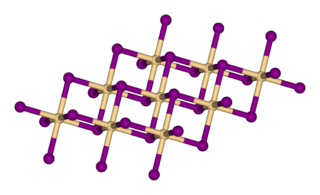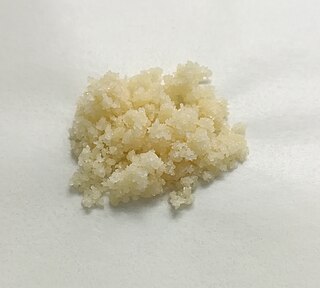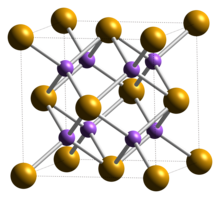
Selenium is a chemical element with the symbol Se and atomic number 34. It is a nonmetal with properties that are intermediate between the elements above and below in the periodic table, sulfur and tellurium, and also has similarities to arsenic. It seldom occurs in its elemental state or as pure ore compounds in Earth's crust. Selenium was discovered in 1817 by Jöns Jacob Berzelius, who noted the similarity of the new element to the previously discovered tellurium.

Potassium oxide (K2O) is an ionic compound of potassium and oxygen. It is a base. This pale yellow solid is the simplest oxide of potassium. It is a highly reactive compound that is rarely encountered. Some industrial materials, such as fertilizers and cements, are assayed assuming the percent composition that would be equivalent to K2O.
A selenide is a chemical compound containing a selenium with oxidation number of −2. Similar to sulfide, selenides occur both as inorganic compounds and as organic derivatives, which are called organoselenium compound.
Hydrogen selenide is an inorganic compound with the formula H2Se. This hydrogen chalcogenide is the simplest and most commonly encountered hydride of selenium. H2Se is a colorless, flammable gas under standard conditions. It is the most toxic selenium compound with an exposure limit of 0.05 ppm over an 8-hour period. Even at extremely low concentrations, this compound has a very irritating smell resembling that of decayed horseradish or 'leaking gas', but smells of rotten eggs at higher concentrations.

In chemistry tellurate is a compound containing an oxyanion of tellurium where tellurium has an oxidation number of +6. In the naming of inorganic compounds it is a suffix that indicates a polyatomic anion with a central tellurium atom.
Organoselenium chemistry is the science exploring the properties and reactivity of organoselenium compounds, chemical compounds containing carbon-to-selenium chemical bonds. Selenium belongs with oxygen and sulfur to the group 16 elements or chalcogens, and similarities in chemistry are to be expected. Organoselenium compounds are found at trace levels in ambient waters, soils and sediments.

Aluminium selenide is the inorganic compound with the formula Al2Se3.
Selenium trioxide is the inorganic compound with the formula SeO3. It is white, hygroscopic solid. It is also an oxidizing agent and a Lewis acid. It is of academic interest as a precursor to Se(VI) compounds.

Selenium compounds commonly exist in the oxidation states −2, +2, +4, and +6.

Carbon diselenide is an inorganic compound with the chemical formula CSe2. It is a yellow-orange oily liquid with pungent odor. It is the selenium analogue of carbon disulfide (CS2) and carbon dioxide (CO2). This light-sensitive compound is insoluble in water and soluble in organic solvents.

Sodium selenide is an inorganic compound of sodium and selenium with the chemical formula Na2Se.

Titanium diselenide (TiSe2) also known as titanium(IV) selenide, is an inorganic compound of titanium and selenium. In this material selenium is viewed as selenide (Se2−) which requires that titanium exists as Ti4+. Titanium diselenide is a member of metal dichalcogenides, compounds that consist of a metal and an element of the chalcogen column within the periodic table. Many exhibit properties of potential value in battery technology, such as intercalation and electrical conductivity, although most applications focus on the less toxic and lighter disulfides, e.g. TiS2.
Phosphorus selenides are a relatively obscure group of compounds. There have been some studies of the phosphorus - selenium phase diagram and the glassy amorphous phases are reported. The compounds that have been reported are shown below. While some of phosphorus selenides are similar to their sulfide analogues, there are some new forms, molecular P2Se5 and the polymeric catena-[P4Se4]x. There is also some doubt about the existence of molecular P4Se10.

Triphenylphosphine selenide is an organophosphorus compound with the formula (C6H5)3PSe. It is a white solid which is soluble in most organic solvents. The compound is used in the preparation of other selenium compounds and is itself prepared by the reaction of triphenylphosphine with potassium selenocyanate. Single crystals have been isolated with both monoclinic and triclinic structures (space groups: P21/c and P1 respectively); in both cases the geometry at phosphorus is tetrahedral.

Potassium selenocyanate is the inorganic compound with the formula KSeCN. It is a hygroscopic white solid that is soluble in water, decomposing in air to red selenium and potassium cyanide. The compound has been characterized by X-ray crystallography, which confirms that it is a salt. The C-N and C-Se distances are 112 and 183 pm, respectively consistent with triple and single bonds.

Hydrogen diselenide is an inorganic selenium compound with a chemical formula H2Se2 or (SeH)2. At room temperature, hydrogen diselenide dissociates easily to hydrogen selenide and elemental selenium, and is therefore not stable. However, hydrogen diselenide can be stable in some solutions.

Lithium selenide is an inorganic compound that formed by selenium and lithium. It is a selenide with a chemical formula Li2Se. Lithium selenide has the same crystal form as other selenides, which is cubic, belonging to the anti-fluorite structure, the space group is , each unit cell has 4 units.

Rubidium sulfide is an inorganic compound and a salt with the chemical formula Rb2S. It is a white solid with similar properties to other alkali metal sulfides.

Caesium sulfide (also spelled cesium sulfide in American English) is an inorganic salt with a chemical formula Cs2S. It is a strong alkali in aqueous solution. In the air, caesium sulfide emits rotten egg smelling hydrogen sulfide.

Rubidium selenide is an inorganic compound composed of selenium and rubidium. It is a selenide with a chemical formula of Rb2Se. Rubidium selenide is used together with caesium selenide in photovoltaic cells.
















